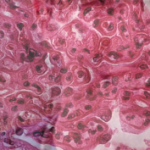Lupus has always had a reputation for being a wild, unrestrained and enigmatic entity. In fact, the very name lupus comes from the Latin word for wolf, a gift from our Roman predecessors who saw a resemblance between lupus rashes and a wolf’s bite. Given the limitations of immunology back then, it is an incredibly fitting term. But things are changing, and the metaphor of this unstoppable, utterly ferocious creature seems to finally be breaking down. Perhaps the best example of this is how we are finally learning to domesticate lupus nephritis. How so? Well, let’s rheuminate!
I salute our clinical mentors who tried their absolute best to tame lupus with whatever tools they could find, such as high-dose corticosteroids, cytotoxic agents and potent immunomodulators. Without a doubt, these treatments work, but they come at a price. We can muzzle the wolf for a while, but, even for the fortunate, the return of lupus from remission is always a looming threat.
That’s not even taking into account medication side effects, co-morbidity and multimorbidity, and the threat of ongoing kidney damage, such as arteriosclerosis. It is safe to say that we have been able to manage the disease, but we have felt uneasy in maintaining control. That’s what makes this moment in lupus nephritis so remarkable. After decades of hard-fought progress, we are finally beginning to see the wolf respond to a gentler leash. Targeted therapies, such as belimumab and voclosporin, offer new options, not just for suppressing inflammation, but for preserving renal function with greater precision. Newer medications, such as dapirolizumab and obinutuzumab, are showing promising results in clinical trials. These treatments help reshape the behavior of the beast, allowing us to guide the wolf rather than to wrestle it.
We’re also getting smarter about how we understand lupus nephritis. Urine biomarkers, molecular profiling and better disease activity measures are giving us clearer signals about when the wolf is growling. These options can provide supplementary information to the more invasive kidney biopsy. Additionally, newer understanding of autoantibody patterns is providing better clarity about prognosis and disease activity.
Of course, no metaphor is perfect. Lupus will always retain some of its wildness. It doesn’t follow rules, and it certainly doesn’t respond the same way in every patient. Similarly, wolves are not our implacable enemies, but rather are important guardians of our ecosystems, and, as much as I love dogs, not all of them are predictable, affectionate furry bundles of love. Nevertheless, I look forward to seeing the day that we teach our medical students that the disease our Roman forebearers likened to a fearsome wolf has become a known entity, which still requires respect and attention, but is closer to a chihuahua than a dire wolf.



